Wish to protect your goods while moving house? this article will walk you through the Top 7 Best Packing Material For Moving.
One of the best feelings after a house move is finding everything you packed intact and undamaged, and the best way to ensure this is to pack your belongings carefully. So, what kind of safeguards should you put in place? What’s the best way to pack for a long-distance move?
1. Packing Paper – Top 7 Best Packing Material For Moving
When it comes to moving, packing paper is the first thing that comes to mind. Almost anything can be wrapped in it, making it an excellent first line of defense.
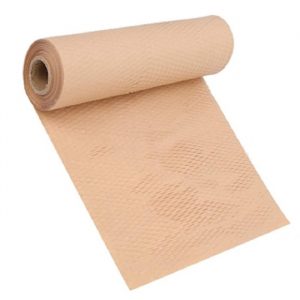
Using packing paper has its advantages.
- Packing paper is very gentle to the surfaces it comes into contact with because of its softness and smoothness. Because it is free of acid and ink, it will not damage or stain the surfaces. As a result, even the most delicate items (such as glass, crystal, china, fine artwork, sensitive electronics, etc.) can be safely packed in packing paper.
- Due to paper’s inherent flexibility and ability to adhere to irregular surfaces, it is an excellent material for wrapping fragile objects.
- It’s easier to stack or bundle items that have been individually wrapped in packing paper because the sheets are thin and take up less space;
- Large rolls of packing paper can be purchased for less than $20, while a large pack of 500 sheets of packing paper costs between $25 and $30.
The benefits of packing paper are numerous, but it isn’t necessarily the best option for moving because it isn’t very strong and can be easily torn when it comes into contact with a sharp object. Paper, on the other hand, offers no protection against moisture and is prone to breaking.
2. Bubble wrap -Top 7 Best Packing Material For Moving
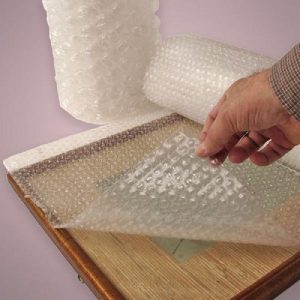
Packing breakables is made easier by the use of bubble wrap, which is ideal for protecting delicate items during a move.
The benefits of bubble wrap
- Protecting fragile items from shocks and vibrations is a great benefit of bubble wrap because the air-filled bubbles absorb the shock of an impact, so even if an item is dropped or topples over or bumps into another item it should not break.
- If you’re looking for bubble wrap in a specific form or size, you’ll be able to find it quickly and easily because it’s available in a variety of forms and sizes.
- The air-filled material is light and does not increase the weight of your boxes.
- You can safely wrap any object with bubble wrap because it can conform to almost any shape.
- You can save money on packing supplies for your next move thanks to the durability of the plastic material, which can be reused multiple times.
Bubble wrap is one of the best packing materials for moving, given the above considerations. Despite these drawbacks, it is still a viable option for those who are looking for an environmentally-friendly and cost-effective solution (unless you buy bio-degradable bubble wrap which is much more expensive). Besides that, using plastic directly on delicate surfaces isn’t recommended because it can stick to the surface and smear it, especially in hot weather conditions.
The contest between bubble wrap and packing paper
With that in mind, is bubble wrap or packing paper the better option for protecting fragile items during shipping?
Wrap your fragile items in packing paper first, then add a layer of bubble wrap to ensure maximum protection during a move. The bubble wrap will cushion the item and absorb any shocks, reducing the risk of breakage, while the packing paper will be safe to use on the delicate surface and fit snugly around the item. This is the absolute pinnacle of security.
3. Packing foam – the best option on the scale
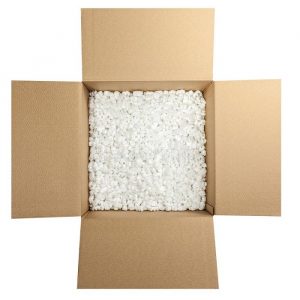
To keep your valuables safe and sound during the arduous relocation process, packing foam is an excellent choice.
Foam packing has many advantages.
- Shock absorption, vibration dampening, and thermal insulation are all provided by packing foam. It protects electronics, artwork, jewelry, and other delicate and sensitive items to an unprecedented degree;
- Non-abrasive foam products are ideal for storing delicate items.
- Foam sheets, foam rolls, foam pouches, and foam corner guards are all forms of packing foam that can be used in a variety of ways.
- Cushioning for oddly shaped items can be created using foam sheets, which easily conform to any shape.
- Because foam wrap is so strong and resilient, it’s ideal for protecting bulkier items like furniture and appliances from being crushed by fragile packing peanuts and bubble wrap.
Packaging foam is one of the best materials for protecting goods during transport. Despite this, it’s a significant financial burden.
Bonus tip: Foam is great for cushioning, but it’s too expensive to use as a space filler. Even if you have some foam pieces that can’t be used for packing (torn pieces, for example), use them to add extra padding to a moving container (one that contains breakables).
4. Packing peanuts – the best space fillers
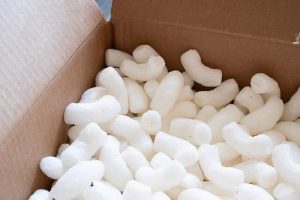
To prevent items from shifting or breaking during transport, packing peanuts can be used to fill empty spaces in moving boxes.
Simply cover the bottom of a box with a layer of peanuts, place your securely wrapped item(s) inside, then fill the rest of the space with the small styrofoam or starch pieces that are commonly used for packaging. Once the pieces have settled and filled any gaps, add more peanuts to the carton. Packing tape should be used to seal the box shut.
Bonus tips:
- Packing peanuts, while excellent cushioning, are ineffective if used alone, so make sure to use packing paper or bubble wrap before placing your item in the box.
- It is important to remember that heavy items can crush packing peanuts;
- The non-toxic and biodegradable starch peanuts are a better option than styrofoam packing peanuts because they don’t have an electrostatic charge, making them safer for electronics. However, they’re a bit pricey.
>> Related Articles: TOP 10 TIPS TO MOVE BY YOURSELF
5. Plastic wrap – the most versatile material for packaging
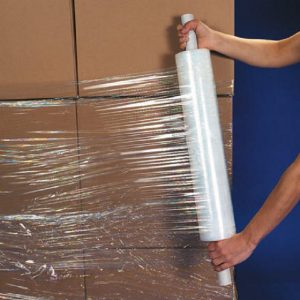
In contrast to other packing materials, plastic wrap can be used in a wide range of ways during a move, from protecting items from dust and dirt to securing doors and drawers to preventing items from falling out.
Your items will be safe because the plastic does not leave a sticky residue on the surface it is attached to, and it is inexpensive and recyclable. Using stretch wrap directly on wood or leather can cause moisture to get trapped beneath the plastic and ruin the polished finish of wooden pieces, cause the leather or wood to warp, or result in mold growth.
>> Related Articles: TOP 9 TIPS FOR PLANNING A HOUSE MOVE
6. Cardboard – protective material that you’d never expect
The connotation of “cardboard box for packing” is associated with the words “packing” and “cardboard.” Although cardboard can be used in a variety of different ways during a house move, it is most commonly used as a cushion.
With painter’s tape, you can secure a cardboard cutout over a screen, mirror, or glass piece of furniture. Wrap the entire item in bubble wrap on top of the cardboard cover for maximum protection.
>> Related Articles: TOP 10 WAYS THE FINAL MOVING COST CAN BE INCREASED
7. Clothes, towels, blankets, and other fabrics – alternatives to traditional packaging
You can save money by using fabric instead of specialized padding and wrapping materials:
- All kinds of household items can be protected by thick, soft fabrics, which are ideal for cushioning.
- Rather than purchasing bubble wrap, foam padding, and other professional protective materials, you save money by using items you already own at home instead.
- Your fabric items are going to have to be moved anyway, so using them as packing materials feeds two birds with a single scone of bread.
Packing with fabric is a little more cumbersome than using professional cushioning materials because it takes up more space in the box and is heavier (so they will make the box heavier).
>> Related Articles: TOP 5 CREATIVE WAYS TO ANNOUNCE PEOPLE YOU ARE MOVING



